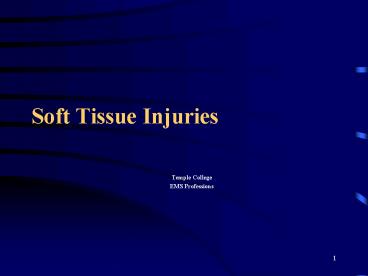Soft Tissue Injuries - PowerPoint PPT Presentation
1 / 24
Title:
Soft Tissue Injuries
Description:
Title: Bleeding and Shock Author: Chris R. Black Last modified by: Juliane Created Date: 9/15/1998 2:51:20 PM Document presentation format: On-screen Show (4:3) – PowerPoint PPT presentation
Number of Views:91
Avg rating:3.0/5.0
Title: Soft Tissue Injuries
1
Soft Tissue Injuries
- Temple College
- EMS Professions
2
Skin Anatomy and Physiology
- Bodys largest organ
- Three layers
- Epidermis
- Dermis
- Subcutaneous tissue
3
Skin Anatomy and Physiology
- Complex system, variety of functions
- Sensation
- Control of water loss
- Protection against microbes
- Temperature control
4
Soft Tissue Injuries
- Closed
- Open
5
Closed Injury
- Associated with blunt trauma
- Skin remains intact
- Damage occurs below surface
- Types
- Contusions
- Hematomas
6
Contusion
- Produced when blunt force damages dermal
structures - Blood, fluid leak into damage area causing
swelling, pain - Presence of blood causes skin discoloration
called ecchymosis (bruise)
7
Hematoma
- Blood lump
- Larger blood vessel damaged
- Causes mass of blood to collect in the injured
area - Fist-sized hematoma 10 volume loss
8
With Closed Soft Tissue Injury
- How much blood is tied up in that injury rather
than circulating in the vessels? - What could the force the caused the soft tissue
trauma have done to underlying organs?
9
Closed Injury Management
- Rest
- Ice
- Compression
- Elevate
- Splint
When in doubt assume underlying fractures are
present
10
Open Injury
- Skin broken
- Protective function lost
- External bleeding, infection become problems
11
Open Injury Types
- Abrasions
- Lacerations
- Punctures
- Avulsions
- Amputations
12
Abrasion
- Loss of portions of epidermis, upper dermis by
rubbing or scraping force. - Usually associated with capillary oozing, leaking
of fluid - Road rash
13
Laceration
- Cut by sharp object
- Typically longer than it is deep
- May be associated with severe blood loss, damage
to underlying tissues - Types
- Linear
- Stellate
14
Punctures
- Result from stabbing force
- Wound is deeper than it is long
- Difficult to assess injury extent
- Object producing puncture may remain impaled in
wound
15
Avulsions
- Piece of skin torn loose as a flap or completely
torn from body - Result from accidents with machinery and motor
vehicles - Replace flap into normal position before
bandaging - Treat completely avulsed tissue like amputated
part
16
Amputations
- Disruption of continuity of extremity or other
body part - Part should be wrapped in sterile gauze, placed
in plastic bag, transported on top of cold pack - Do NOT pack part directly in ice
- Do NOT let part freeze
17
Open Wound Management
- Manage ABCs first
- Control bleeding
- Prevent further contamination, but do not worry
about trying to clean wound - Immobilize injured part
- Mange hypoperfusion if present
18
Special Considerations
- Impaled objects
- Eviscerations
- Open chest wounds
- Neck wounds
- Gunshot wounds
19
Impaled Objects
- Do NOT remove
- Stabilize in place
- Exception
- Object in cheek
- Remove, dress inside and outside mouth
20
Eviscerations
- Internal organs exposed through wound
- Cover organs with large moistened dressing, then
with aluminum foil or dry multi-trauma dressing - Do NOT use individual 4 x 4s
- Do NOT attempt to replace organs
21
Open Chest Wound
- May prevent adequate ventilation
- Cover with occlusive dressing
- Monitor patient for signs of air becoming trapped
under pressure in chest (tension pneumothorax) - If tension pneumo develops lift dressing corner
to relieve pressure
22
Neck Wounds
- Risk of severe bleeding from large vessels
- Risk of air entering vein and moving through
heart to lungs - Cover with occlusive dressing
- Do NOT occlude airway or blood flow to brain
- Suspect presence of spinal injury
23
Gunshot Wound
- Special type of puncture wound
- Transmitted energy can cause injury remote from
bullet track - Bullets change direction, tumble
- Impossible to assess severity in field or ER
- Patient must go to OR
24
PowerPoint Source
- Slides for this presentation from Temple College
EMS http//www.templejc.edu/dept/ems/pages/power
point.html

